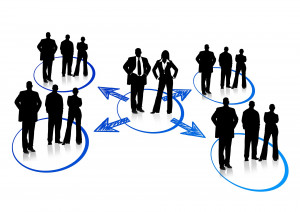![]()
When we think of leadership, we often conjure up images of individual heroic figures who made their mark on history. Our culture loves to celebrate its heroes. Many of our treasured national park sites include statues, monuments, and memorials to the likes of George Washington, Martin Luther King Jr., and Theodore Roosevelt.
Our persistent culture of hero-worship, eagerly reinforced by Hollywood, frequently causes those of us who aspire to positions of leadership in public service to believe we must be strong, organizational leaders who direct and manage the actions of others. However, the myth of the heroic leader was never as absolute as it seemed, and the world has fundamentally changed in the last century. We’ve moved beyond the industrial revolution into the knowledge economy. It’s time we accept that our commonly held misconceptions about leadership can stunt our own effectiveness as leaders.
Challenges in our Modern World
In the book Leadership Without Easy Answers, Ron Heifetz writes that organizations today face two types of challenges: technical challenges, those we know how to solve, and adaptive challenges, which require changing people and the systems we have created – usually because of an environmental change, a new technology, or other development. Adaptive challenges include poverty, climate change, or workplace culture; these are issues that require thoughtful, often novel approaches; prior experience with similar challenges may not be applicable. Solving them will require ongoing creativity as well as behavioral and attitudinal change over time.
Today, the majority of government agencies, global corporations and nonprofits operate under a structure introduced in the late 1800s. This system is familiar to all of us; the pyramid-shaped org chart with lots of employees at the bottom, middle managers in the next rows, followed by increasingly fewer senior executives as you move towards the top. This system works well; it is efficient, excels at planning and organizing, and solving technical problems. However, it can bog down when faced with complex, systemic, adaptive challenges. Organizations today face far more adaptive challenges than they did in the past. It is simply no longer possible for one or two heroic individuals to “figure it all out at the top”; we need integrated thinking, information sharing, and action at all levels. Within the public sector, there is a critical role for intentional, smart networks working toward a common vision with the goal of making a difference.

Networks offer many of the same advantages as a start-up; they are fast, flexible, adaptable and innovative. Action in networks is self-organizing. Self-organization occurs when an individual or group sees an opportunity to do something, and takes action to pull others together to intentionally initiate movement. When leaders encourage and empower self-organizing, many more people will initiate collaborative projects.
Hurricane Sandy
When these traits are paired with the efficiency and productivity of formal agency structures, leaders can successfully capitalize and leverage the strengths of both. For example, In the wake of hurricane Sandy, the Occupy Sandy Network was actually able to provide faster relief and aid than FEMA. Because they had such a wide, distributed network already in place from Occupy Wall Street, they were able to quickly reach out to those on the periphery of their network and determine where the most dire needs existed in the wake of Hurricane Sandy, and could quickly move aid to those areas. Organized agencies like FEMA and the Red Cross provided the supplies; Occupy Sandy knew where they needed to go.
Our great fondness for heroes often prevents us from seeing that effective leadership is all about networks – now more than ever. Would George Washington be revered as he is without the likes of Adams, Jefferson, Greene, Madison, or Hamilton? Would Martin Luther King Jr. have risen to lead the civil rights movement in the absence of Rosa Parks, E.D. Nixon, John Lewis, Ella Baker, and the Student Nonviolent Coordinating Committee? Could Theodore Roosevelt have been the unflinching champion of conservation without Gifford Pinchot, George Grinnell, John Muir, or the pioneering work of George Perkins Marsh?
Leaders must be aware of the networks that exist around them as well as the opportunities to develop intentional networks and coordinate their actions for maximum effect. With whom do you regularly work and interact? How diverse is your network of connections? Are your networks informal & social or organized and intentional? The beauty of networks lies in their adaptability. There are many ways to implement and organize them. How will you as a leader go about doing so?
Dylan Mroszczyk-McDonald is part of the GovLoop Featured Blogger program, where we feature blog posts by government voices from all across the country (and world!). To see more Featured Blogger posts, click here.





According to American historian David E. Stannard, George Washington the father of our country did not seem to like American Indians very much. In 1783, he compared American Indians to wolves when he proclaimed, “Both being beast of prey, tho’ they differ in shape.”
It appears that the “scorched earth policy” so brilliantly implemented by General William Sherman during a Civil War between mostly white people, was first implemented in American warfare by generals under Washington’s command. While attacking the Iroquois people, the tribe whose constitution was copied by the Founding Fathers, Washington ordered Major General John Sullivan in 1779 to “lay waste all the settlements around…that the country may not be merely overrun, but destroyed.” Washington also instructed Sullivan to not “listen to any overture of peace before the total ruin of their settlements is effected.”
Stannard reminds us that Washington was a huge advocate of exterminating American Indians as evidenced by his troop’s practice of skinning the bodies of dead Iroquois. I bet you thought American Indians were the first ones to initiate scalping and mutilation. The skin removed from the hips down was often used as boot tops or leggings.
American Indians who were lucky enough to endure the military exploits of Washington gave our country’s first president the nickname “Town Destroyer.” Stannard noted that 28 to 30 Seneca tribal settlements were also destroyed by Washington and his combatants.
Lest we forget the fourth face on Mount Rushmore, the “Rough Rider” Teddy Roosevelt.
Even white historians agree that Roosevelt held the following biases against Native people:
• The US was generous to the Indians, paying them many times what their land was worth.
• Indians broke just as many treaties as white men did.
• That just and honorable nations like the US can break treaties whenever they choose.
• That international law and morality don’t apply to indigenous people.
• It was US policy to kill and conquer Indians and take their land.
Here are just some of the nasty things Roosevelt had to say about my ancestors:
• All the men of sane and wholesome thought must dismiss with impatient contempt the plea that these continents should be reserved for the use of scattered savage tribes, whose life was but a few degrees less meaningless, squalid, and ferocious than that of wild beasts with which they held joint ownership.
• It is as idle to apply to savages the rules of international morality which obtain between stable and cultured communities.
• The most righteous of all wars is a war with savages.
• In their paint and their cheap, dirty finery, these savages did not look very important.
• The ravages committed by these skulking parties of murderous braves were monotonous in their horror.
• Indians are reckless, revengeful, fiendishly cruel, they rob and murder.
• We need not waste our time in dealing with any sentimentalist who believes that, on account of any abstract principle, it would have been right to leave this continent to the domain, the hunting ground of squalid savages. It had to be taken by the white race.
• The General Allotment Act is a mighty pulverizing engine to break up the tribal mass.
• The truth is the Indians never had any real title to the soil.
Let’s not forget the slave owning Thomas Jefferson. Stannard also included Jefferson in the prestigious group of Presidents who felt American Indians should be vanquished from the country they discovered. Jefferson’s War Department in 1807 had explicit instructions from this slave owner that any Indian resistance should be met with “the hatchet.” Jefferson further opined, “And…if ever we are constrained to lift the hatchet against any tribe, we will never lay it down till that tribe is exterminated, or is driven beyond the Mississippi, we shall destroy all of them.”
Jefferson was also in total agreement with Washington on the animalistic nature of American Indians when he described them as “nothing human except the shape” as well as” merciless savages.”
How diverse is your network of connections? How diverse are your leadership role models that value people who do not look like them, talk like them or act like them.
What gets measured gets talked about. What gets talked about continue to gets talked about as it promotes a world where only certain people count. How about highlighting leaders for a change that do justice, love kindness and walk humbly on the face of the earth. That is the kind of network I am looking for.
Hi Richard. Thanks for your very thoughtful and well-articulated comment. I’m in complete agreement with your statement “what gets measured gets talked about.” There is no doubt our history has been told with a bias towards the “victors” (read white, wealthy, European men.) In fact, that is one of the points I’m highlighting in this piece. Our society tends to glorify these individuals while overlooking the myriad sources of influence also part of their legacy. Without question many of their personal views about native Americans would not be tolerated today. I use them as example here simply because of their larger-than-life stature in folk history – rightly or wrongly. In my opinion, there are few network leaders who embody the spirit of love, compassion, and humility than Martin Luther King Jr. Our world certainly needs more leaders with his spirit, kindness, and optimism. That’s precisely what I advocate for here and I certainly hope you agree. Thank you!
I appreciate your response.